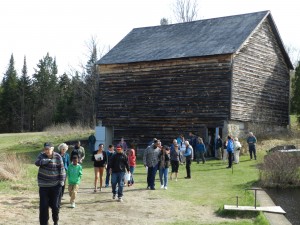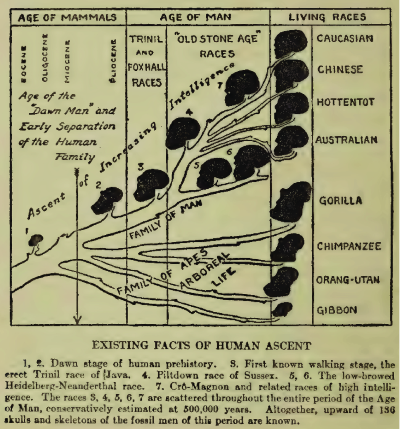
Slavery and New York State have a long history together. Indeed, the history of slavery in New York predates the birth of New York as an English and originates in the days of New Netherland, part of the extensive international slave trade.
As we are regularly reminded by events today, slavery has not disappeared. The current issue of Time includes an article on the worldwide continuance of slavery today, especially targeting young women and girls.
What does this have to do with New York history today?
The following comes from the website of NYSOPRHP for John Brown Farm State Historic Site.
High in New York State’s Adirondack Mountains is the home and grave of abolitionist John Brown. Many Americans know the song “John Brown’s body lies a-mouldering in the grave,” but most do not associate the words with this simple farm at North Elba, New York….[After his hanging, h]is body was returned to North Elba and was buried in front of his home on December 8, 1859. The remains of several of Brown’s followers, who fought and died at Harper’s Ferry, were moved to this small graveyard in 1899.
His spirit lives on in New York in a continued crusade against slavery. According to Martha Swan, “John Brown Day dates back to a tradition started in the 1930s of making a pilgrimage to the North Elba gravesite of abolitionist John Brown and his sons and other Harpers Ferry Raiders who sacrificed their lives in the struggle to end slavery.”
I met Martha Swan several years ago at a Conference on New York State History where she had a display table for John Brown Lives! Martha, a Spanish teacher in Newcomb, helped found John Brown Lives! in 1999 “to engage Adirondack communities in the freedom history of their region and to promote social justice and human rights.”
John Brown Lives! programs include the traveling “Dreaming of Timbuctoo” exhibit and the mission of the organization is to free the 27 million men, women and children held in some form of slavery in the world today, something everyone should be more aware of due to Boko Haram’s recent kidnapping of hundreds of girls and the declaration that they would be sold into slavery.
For John Brown Day in 2014, a special screening of the new film 12 Years a Slave was held. Although the NYS historic marker is in Saratoga Springs, Solomon Northup’s story involves the Adirondacks as he was born in what is now Minerva (then in the Town of Schroon Lake). Martha’s program also included a book discussion of 12 Years A Slave, speakers, a workshop for educators, and an outdoor commemorative event at the John Brown Farm State Historic Site in Lake Placid.
If a tree falls in the woods and it is not on YouTube, has anything happened? If a history event occurs outside the designated Path weekends, does it count? Can the Governor brag about it? Civil rights is one of the themes of the Path through History. The website even mentions John Brown’s farm in the text describing the state’s commitment to civil rights. The site is listed along with many other sites throughout the state related to the theme but there is no mention of John Brown’s Day or John Brown Lives! Which are not destination sites because they are not sites.
In other words, if you wanted to attend the conference, meaning bringing heads to beds in upstate New York, the ostensible goal of the Path through History, you wouldn’t know about from the Path through History website. Obviously Martha did not get the memo about scheduling events on the designated June weekends or they don’t count. While one can enter events on the website for other dates, there is no connection on the website between the listing of itinerary sites and the events which may be held at those sites. So even if the event was listed as a Path weekend listing, someone searching on the itinerary sites wouldn’t know. And since John Brown Lives! isn’t a site, it would not be listed anyway.
John Brown Day this year also reminds us of the impact of Solomon Northup due to the movie. It has generated interest in other incidents involving the kidnaping of blacks, Sue Eakin, the historian who broke the story through her research, David Fiske, who co-authored the book that brought the printed story to the public, Renee Moore who has labored 15 years promoting the story in Saratoga Springs. Bob Cudmore who writes about the Mohawk Valley, wrote about the connection to Fulton County through the lawyer who aided him was from. Kelly Yacobucci Farquhar, Montgomery County Historian, held a book discussion and there were many other talks and discussions throughout the state.
A search for Solomon Northup on the Path website turned up the following:
Search: Solomon Northup
Title Civil Rights
Description New York was a national center for abolitionism, where the NAACP was created and the birthplace of the modern gay rights movement. Sites across the state bring this heritage to life for
Title Arts & Culture
Description New York’s writers, artists, musicians, dancers, performers, fashion designers and architects have been at the forefront of American culture. Visitors can explore the dazzling array of N
I am not sure exactly what this means, what one should do next, or why the descriptions were truncated. Lakes to Locks Passage has created the “12 Years a Slave” online itinerary based on folklore, local legends and oral sources including the John Brown Farm State Historic Site. The next steps would be to take it to tour operators and to revise the Path website to show itineraries which have been created.
In a previous post, I wrote about the Freedom Trail project of Governor Pataki in which Cordell Reaves was involved. When Pataki left office the project died and Reaves was reassigned to NYS Office of Parks Recreation and historic Preservation where he works now. No one in a central position in New York State has assumed the mantle of leadership for telling the story of slavery in New York. Besides the people mentioned above, others have sought to tell story, often like Martha, in addition to their day jobs. For example, Paul and Mary Liz Stewart, Underground Railroad History Project of the Capital Region, Inc. (URHPCR), now affiliated with Sage College, Ulster County historian Anne Gordon who led the effort to erect a statue dedicated to Sojourner Truth last fall in Ulster, Cliff Mealy who has added Solomon Northup to his repertoire as a re-enactor, Rebecca Edwards, Vassar College who created the Mid-Hudson Antislavery Project now based at the Congregational Church in Poughkeepsie, Edythe Ann Quinn, Hartwick College, who writes about the blacks in the Hills from her stint as Harrison Town Historian near where I live, Dot Willsey and others in Peterboro, home of abolitionist Gerrit Smith, and Seneca Village in Central Park and Weeksville in Brooklyn, honoring the New York Regiment Colored Troops (USCT) and on the list goes on of the stories of slave and free blacks in New York. The effort to tell the story of slavery in New York is one embraced by many hardworking people engaged in a labor of love and duty and obviously not for money.
I attended a Memorial Day commemoration at the Town of Rye African Cemetery. I asked Dave Thomas of the Town of Rye, who spearheaded the rescue of the segregated cemetery from its decrepit and overgrown state, to submit a post on the subject here at The New York History Blog. The point is there are many such stories to be told throughout the state. These sites are often small, understaffed, and aren’t even always sites but people who gather today to promote events so we remember our history, we remember what happened in the communities where we now live, that our sense of place, our sense of belonging includes these stories too.
These are the type of events, people, and organizations which would benefit from leadership from Albany and why I encourage your support the creation of the New York State History Commission.
Photo: Participants emerge from a talk at the John Brown Farm State Historic Site on John Brown Day 2014 (courtesy John Warren).






“These are the type of events, people, and organizations which would benefit from leadership from Albany and why I encourage your support the creation of the New York State History Commission.”
Arguably it would benefit from leadership… though there already supposedly is leadership when it comes to the history of slavery in New York State: The Amistad Commission http://www.dos.ny.gov/amistad/index.html
In reality, there’s been a lack of leadership there:
Hu, Winnie. “4 Years After Black History Panel’s Birth, Its Work Is Still Deferred.” N.Y. Times. February 11, 2009. http://www.nytimes.com/2009/02/12/education/12amistad.html
Hu, Winnie. “Three Are Named to Black History Panel.” N.Y. Times. February 12, 2009. http://cityroom.blogs.nytimes.com/2009/02/12/three-are-named-to-black-history-panel/
Lombardi, Frank. “It’s time to put wind in Amistad panel’s sails to teach kids about African-American slavery history.” N.Y. Daily News. May 26, 2011. http://www.nydailynews.com/new-york/uptown/time-put-wind-amistad-panel-sails-teach-kids-african-american-slavery-history-article-1.147659
There is supposed to be nineteen members but I count seventeen at http://www.dos.ny.gov/amistad/members.html and the first three are probably not involved at all but rather unnamed designees of theirs (if that). As for the others, who are they? There’s no capsule biographies, no links; Frederick Harris and James Turner are rather common names, making identifying them difficult. Which politicians appointed which members? Which politician(s) have failed to appoint people to the Commission? People on the Commission serve three year terms, and some of them were appointed over three years ago, suggesting they were reappointed – despite the Commission’s lack of work. Next meeting “To Be Announced” (OK – when?) http://www.dos.ny.gov/amistad/meetings.html
Together they’re supposed “to prepare reports for the governor and the legislature regarding its findings and recommendations on facilitating the inclusion of the African slave trade, American slavery studies, African-American history and special programs in the educational system of the state.” AFAIK, in nine years they haven’t prepared a single report.
There are any number of interesting stories, and no doubt many of them still haven’t been fully researched, e.g.:
“On the wall outside of 5 State Street is a plaque which commemorates the famous rescue. It was placed here many years ago, but restored by local citizens in 1987.
“In the basement of the building is a chamber that bears the resemblance of a slave pen. Efforts are in process to determine accurately if this is the case.”
http://undergroundrailroadhistory.org/a-troy-story-of-the-underground-railroad-in-rensselaer-county/
The plaque that was restored was not the original one according to the article “Patriotic Group to Replace Nalle Rescue Tablet.” Troy Times. June 5, 1933: 5 col 5.
The cell might be a cell, or it might be a walled-off tunnel:
“if walls could speak, perhaps some adventurous stories could be heard from the shadows of the past in its cellar where fugitive slave prisoners were held. A tunnel led from the cellar to the river two blocks away, through which the fugitives were taken to be shipped down the Hudson to New York and although the tunnel remains are still there, the opening was blocked off in recent years.”
“Thrilling Rescue of Charles Nalle Historic Feature; Sentiment of Public Toward Slavery Shown in Delivery of Negro from Officers Here.” Times Record [Troy, NY]. May 6, 1941: 9 cols 6-7.
Also an unanswered question of sorts:
Carleo-Evangelist, Jordan. “Remains must not be ‘on a shelf forever’; Public thoughts wanted about where and how to rebury 14 slaves.” Albany Times Union. February 8, 2012: B1. http://albarchive.merlinone.net/mweb/wmsql.wm.request?oneimage&imageid=17365481
Vielkind, Jimmy. “Slave burial funds at risk; Appropriation to rebury remains could fall to Cuomo’s veto.” Albany Times Union. April 8, 2013. http://www.timesunion.com/local/article/Slave-burial-funds-at-risk-4419165.php
Have they been reburied yet? If not, why not?
The Amistad Commission is an education-based effort, not an historic site or tourist endeavor. It would be interesting to see where in the new social standards this story is told given all the attention it once received. It should be noted that the website at NYS education refers to this anniversary year (2013) meaning it has not not been updated.
At the history roundtable just held with Assemblyman Englebright on the proposed New York State History Commission, there were no representations from the teacher side. I think there will be as the information gathering for the bill unfolds. One wonders how many commissions like Amistad are floating around out there.
“I am not sure exactly what this means, what one should do next, or why the descriptions were truncated.”
If, in the search results you got, you click on “Civil Rights” or “Arts & Culture” you’ll be taken to pages that have the rest of the text. Neither page has Solomon Northup on it, and I’m guessing they might have been returned as search results due to a partial match just on “north”. If that’s so, that doesn’t make it a very useful search engine, and pages perhaps ought to have custom brief descriptions that don’t truncate.
This search:
https://www.google.com/search?rls=en&q=northup+site:paththroughhistory.ny.gov/&ie=UTF-8&oe=UTF-8
Turns up one page on the Path Through History website where Solomon Northup is mentioned – a page the site’s own search doesn’t turn up:
http://paththroughhistory.ny.gov/cs/Satellite?c=PTH_CanItinerary_C&childpagename=PTH%2FPTH_CanItinerary_C%2FCannedItinerary%2FAdditionalDetail&cid=1362770684422&pagename=PTHWrapper
How much money went into the paththroughhistory.ny.gov website, I shudder to ask?
Congratulations, you are a better navigator than I am in. I salute you for finding a reference to Northup who is connected to the Old Fort Edward Museum on the narrative page you found but not on the listing page I used.
As for you comment on the usefulness of the search engine, I will return to that subject on my next post on immigration in New York History which I will be submitting as soon as I finish responding to the comments on my last post.
I suspect that the programmers were part of the ILoveNY staff already so there was no additional cost. You don’t think they hired consultants do you? Whatever the case, it seems clear that it was tested with actual tourists before going live.
Teachers and others can find activities and lesson plans related to enslavement in the Hudson Valley on our website. For example:
“I See Freedom,” about the life and times of James F. Brown, an enslaved man, who escaped, bought his freedom, and became a noted gardener at Mount Gulian in Beacon, is a multi-disciplinary unit that can be adapted for grades four and up. http://lessons.teachingthehudsonvalley.org/component/option,com_units/Itemid,12/unit_id,61/
“Diversity and Tolerance in the American Colonies,” a social studies unit for grades 7-12, has at least two related activities. http:// lessons.teachingthehudsonvalley.org/component/option,com_units/Itemid,12/id,502/task,view/
Lessons tied to Bronck Farm Museum, Copake Iron Works, Ossining, Philipsburg Manor, Martin Van Buren National Historic Site, and Van Wyck Homestead also touch on the practice of slavry in the Hudson Valley.
Johnson Hall State Historic Site is in the process of further developing the original storehouse/household slave quarters as part of their interpretation of slavery at Johnson Hall. The original research has been presented at conferences, including the Western Frontier Symposium at Fulton Montgomery Community College in Johnstown, NY, at the “John Brown Lives” conference series in Lake Placid, in publications, and as part of the tours at Johnson Hall.
In Oneonta there is a house which is supposedly part of the route of escaping slaves. If you are on Rt. 23, and take the exit to Rt. 7, there is a house on Rt. 23 which has a fireplace with a hidden room behind it. I can’t remember all the details — although I think the house may belong to Hartwick College (my alma mater). If you need more information, I’m sure your contact at the college can tell you much more.
I fully agree with your assessment of Pathways Through History. They have misrepresented the history of Long Island and made a feeble attempt to market NYS’s historic treasures. I’ve brought this to the attention of our local assemblymen but a more organized effort is needed. What about MANY?
Best, Tom
Tom Edmonds, Executive Director
Southampton Historical Museums and Research Center
PO Box 303/17 Meeting House Lane
Southampton, NY 11968
(631) 283-2494
Thanks for writing and for contacting your own state legislators about the problems you are having. Hopefully they will support the proposed New York State History Commission. As it turns out the aide of Long Island Assemblyman Steve Englebright who is sponsoring the legislation just left his position to become Executive Director of MANY. It is reasonable to assume MANY will support the legislation but there is a window during which a former state employee can not lobby his old boss.
But there is something you can do. Can you call a county-wide meeting of the history community to address the issues or add it to the agenda if you already have such meetings?